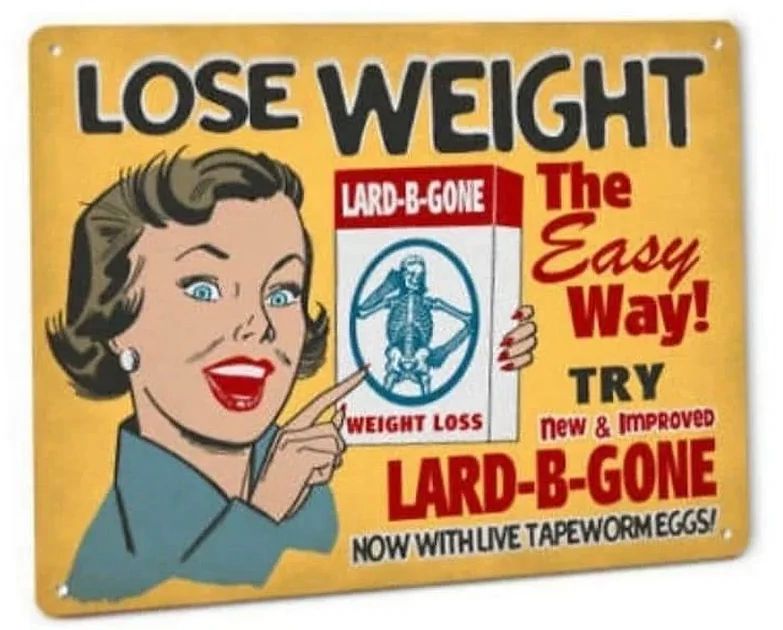People throughout history have always been desperate to find a quick way to shed some extra pounds, but before counting calories was a thing, people would turn to some truly bizarre diets.
From ingesting nothing but air to enjoying tea flavored with raw egg, fad diets have always been weird, nonsensical, and sometimes just downright hilarious.
The Tapeworm Diet
In total opposition to what we now see as good health, people in the Victorian era just adored the on-my-deathbed look.
Back then, consumption, which we now know as tuberculosis, was running rampant through the population, leaving swathes of pale, willowy sufferers in its wake.
Because it affected so many people in the upper class, the sickly, rail-thin appearance of the ill became, for a time, the standard of beauty, and a look that everyone wanted to achieve.
No one actually wanted to contract and die of consumption, though, so how was the beauty-conscious lady of the time supposed to achieve a half-dead visage? The idea might be equally as horrifying as intentionally contracting tuberculosis, and came in the form of something long and squiggly–the ‘tapeworm diet’.

So, what exactly is a tapeworm? A tapeworm is a form of parasite that lives within the host and consumes a portion of the nutrition ingested by the host, leading to fewer calories being processed by the host’s body.
For the tapeworm diet, a person would take a pill that contained live tapeworm eggs, which would potentially hatch inside of their stomach and grow therewithin.
As you can imagine, there was nothing safe or healthy about using a tapeworm to lose weight. Health complications from this fad diet included malnutrition, intentional blockage, and infections from the parasite.
Just as horrifying was how a tapeworm would need to be removed–there are only two ways out, after all!
Combine that with the fact that tapeworms can reach multiple feet in length, and you have a horror movie disguised as a diet.
Lord Byron and His Vinegar Diet
Lord Byron, an iconic Romantic poet who was known for his passionate verses, numerous lovers, and unconventional lifestyle, was also the father of the first strange diet on our list.
It’s believed that Byron suffered from at least one eating disorder throughout his life, some of his writings reflecting his preoccupation with his weight and appearance. Byron tried different alternative diets to maintain what he considered the ideal figure, one of the most infamous being his ‘vinegar diet’.
There was nothing tricky about this diet; the name sums it all up.

Byron would consume vinegar mixed with water throughout the day, sometimes including rice or a cup of tea with a raw egg added.
He believed that the vinegar diet would keep him slim while also helping with his digestion.
It is thought that Byron may have suffered from malaria and sought different diets like the vinegar diet to find relief from the disease, not knowing that he was doing more harm than good.
A few ill health effects that can arise from excess vinegar consumption are:
- Hypocalcaemia, or low calcium
- Hyperreninemia, or high levels of renin
- Osteoporosis, or the weakening and embrittling of bones
The vinegar diet never caught, but a few people did follow in Byron’s footsteps, drinking vinegar to lose weight and suffering because of it.
Inedia, or Breatharianism
If the previous two diets and their singular steps (drink vinegar, swallow worm eggs) sound too complicated, how about a fad diet that is hundreds of years old and involves eating nothing at all?
First popping up in 1670 in the Rosicrucian text Comte de Gabalis, Inedia, more commonly known in modern times as breatharianism, claims that a person can live without consuming food at all, and in some extreme cases, even without water.
Breatharianism has long since been debunked as pseudoscience, and incredibly dangerous, but some still believe that this fad diet is real.
There are two main sources of the idea of breatharianism–religion, and supposed master practitioners that make a profit off of instructing people in this fake diet.
As far as religions go, here are some mentions of long-term fasting in Hindu historical texts, while Taoism encourages Bigu, or a fast that specifically cuts out grains, as a way to get closer to enlightenment.
More insidious are the so-called practitioners of breatharianism who claim to be able to teach others the fasting practice for a cost.
One of the most infamous of these practitioners, Jasmuheen, has failed to prove that she actually practices breatharianism multiple times, and five deaths have been linked to her publications on the extreme fasting practice.
While there are some benefits to short-term fasting, breatharianism is a different creature altogether. Proponents of this dangerous diet claim that bodies don’t consume body fat and muscle when engaging in long-term fasts like most people.
Despite there being numerous claims, no breatharian has been able to offer concrete scientific proof of this.
With the vinegar diet and the tapeworm diet, there are inherent risks, but breatharianism is something else entirely. Several people who have tried to follow breatharianism have died of starvation or dehydration, making this fad diet not just strange but deadly.
The Sylvester Graham Diet
Reverend Sylvester Graham was passionate about bread, which was strange, considering that he spent a good portion of his life encouraging the public to forgo passions or pleasures altogether.
In 1837, Graham published a work describing how strongly he felt about bread and crackers, titled A Treatise on Bread and Bread-Making.
In this work, Graham would go on to malign the additives in bread flour that were used to whiten it or keep it fresh longer.
Instead, Graham firmly believed that grain for bread should be milled at home. He would also go on to include a recipe for the food item he would become most famous for–the Graham cracker.
Sylvester Graham’s food obsessions ran much deeper than mere bread, though. He was a huge supporter of vegetarianism, claiming that the healthiest way to live was to eat, just like Adam and Eve did in the Garden of Eden.
That, and Graham was convinced that eating meat was leading the way to the moral failure of society as a whole.
From these beliefs, ‘Grahamism’ was born. To stay healthy, Graham laid out a life of bland food, hard beds, and lukewarm baths to avoid daily pleasures that may lead to perversion and corruption.
He was staunchly anti-masturbation, believing that it was destroying the American youth and leading to blindness and eventually death.
Oddly enough, Graham died not from old age after decades of following his own fad diet but from receiving excessive opium enemas. He was just 57 years old.
Later, the idea of bland food to improve mental health would be picked up by Dr. John Harvey Kellogg, who would invent Cornflakes as a food source for a sanitarium he was superintendent of.
Kellogg’s hope, like Graham’s, was that the bland Cornflakes would quell the more perverse urges of the sanitarium patients.
Avoiding Swamps Diet
Because we don’t have much information on this diet, consider it somewhat of an honorable mention.
The year was 1727, and author Thomas Short published a piece titled The Causes and Effects of Corpulence, where he described his new fad diet. The problem was that Short’s method to lose weight was less of a diet and more of a relocation plan.
According to Short, overweight people shared one thing in common–swamps. He observed that those who were overweight tended to live near swamps and that it was the swamps causing obesity.
To combat these impossible weight-gaining swamps, Thomas suggested moving to drier, more arid locations where, away from the dreaded swamp, the pounds would simply melt off.

